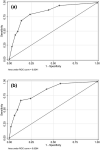Predictive model for bacterial co-infection in patients hospitalized for COVID-19: a multicenter observational cohort study
- PMID: 35488112
- PMCID: PMC9053127
- DOI: 10.1007/s15010-022-01801-2
Predictive model for bacterial co-infection in patients hospitalized for COVID-19: a multicenter observational cohort study
Abstract
Objective: The aim of our study was to build a predictive model able to stratify the risk of bacterial co-infection at hospitalization in patients with COVID-19.
Methods: Multicenter observational study of adult patients hospitalized from February to December 2020 with confirmed COVID-19 diagnosis. Endpoint was microbiologically documented bacterial co-infection diagnosed within 72 h from hospitalization. The cohort was randomly split into derivation and validation cohort. To investigate risk factors for co-infection univariable and multivariable logistic regression analyses were performed. Predictive risk score was obtained assigning a point value corresponding to β-coefficients to the variables in the multivariable model. ROC analysis in the validation cohort was used to estimate prediction accuracy.
Results: Overall, 1733 patients were analyzed: 61.4% males, median age 69 years (IQR 57-80), median Charlson 3 (IQR 2-6). Co-infection was diagnosed in 110 (6.3%) patients. Empirical antibiotics were started in 64.2 and 59.5% of patients with and without co-infection (p = 0.35). At multivariable analysis in the derivation cohort: WBC ≥ 7.7/mm3, PCT ≥ 0.2 ng/mL, and Charlson index ≥ 5 were risk factors for bacterial co-infection. A point was assigned to each variable obtaining a predictive score ranging from 0 to 5. In the validation cohort, ROC analysis showed AUC of 0.83 (95%CI 0.75-0.90). The optimal cut-point was ≥2 with sensitivity 70.0%, specificity 75.9%, positive predictive value 16.0% and negative predictive value 97.5%. According to individual risk score, patients were classified at low (point 0), intermediate (point 1), and high risk (point ≥ 2). CURB-65 ≥ 2 was further proposed to identify patients at intermediate risk who would benefit from early antibiotic coverage.
Conclusions: Our score may be useful in stratifying bacterial co-infection risk in COVID-19 hospitalized patients, optimizing diagnostic testing and antibiotic use.
Keywords: Bacterial co-infection; COVID-19; SARS-CoV-2.
© 2022. The Author(s).
Conflict of interest statement
The authors declare no conflict of interest related to the content of this manuscript.
Figures
References
-
- Vaughn VM, Gandhi TN, Petty LA, Patel PK, Prescott HC, Malani AN, et al. Empiric antibacterial therapy and community-onset bacterial coinfection in patients hospitalized with coronavirus disease 2019 (COVID-19): a multi-hospital cohort study. Clin Infect Dis. 2021;72:e533–e541. doi: 10.1093/cid/ciaa1239. - DOI - PMC - PubMed
Publication types
MeSH terms
Substances
LinkOut - more resources
Full Text Sources
Medical
Miscellaneous


